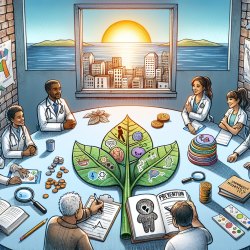Introduction: A New Perspective on Cerebellar Atrophy
As practitioners in the field of speech-language pathology, our goal is to improve outcomes for children with diverse neurological conditions. A recent study titled "Progressive cerebellar atrophy in a patient with complex II and III deficiency and a novel deleterious variant in SDHA: A Counseling Conundrum" provides valuable insights into the genetic underpinnings of cerebellar atrophy, a condition that can significantly impact motor and speech development in children.
Understanding the Study: Key Findings
The study focuses on a 9-year-old boy who exhibited symptoms such as tremor, nystagmus, hypotonia, developmental delay, significant ataxia, and progressive cerebellar atrophy. Genetic analysis revealed biallelic variants in the SDHA gene, including a known pathogenic variant and a variant of unknown significance. The findings indicated a deficiency in complexes II and III of the respiratory chain, consistent with a mitochondrial disorder.
Implications for Practice: Why This Matters
The implications of this study are profound for practitioners who work with children exhibiting similar symptoms. Understanding the genetic basis of cerebellar atrophy can aid in more accurate diagnosis and personalized therapy plans. Here are some ways practitioners can leverage these findings:
- Genetic Counseling: Encourage families to pursue genetic testing when cerebellar atrophy is suspected. This can provide clarity on the condition and guide treatment decisions.
- Interdisciplinary Collaboration: Work closely with geneticists and neurologists to develop comprehensive care plans that address both the neurological and speech-language aspects of the disorder.
- Data-Driven Therapy: Use data from genetic tests to tailor therapy approaches that consider the specific genetic mutations present in the child.
Encouraging Further Research
While this study provides a foundation, further research is essential to explore the full spectrum of SDHA-related disorders and their impact on speech and motor development. Practitioners are encouraged to stay informed about ongoing research and consider participating in studies that explore the intersection of genetics and speech-language pathology.
Conclusion: A Call to Action
By integrating genetic insights into our practice, we can enhance our ability to provide effective, personalized care for children with cerebellar atrophy and related conditions. This study serves as a reminder of the importance of data-driven decision-making in our field.
To read the original research paper, please follow this link: Progressive cerebellar atrophy in a patient with complex II and III deficiency and a novel deleterious variant in SDHA: A Counseling Conundrum.










